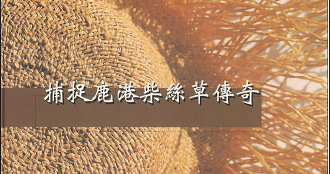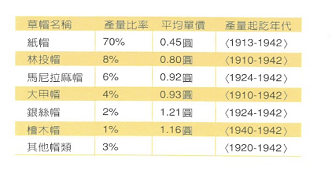
The Legend of Lukang Hinoki Silk Hat
 |
A hinoki silk hat is a straw hat made from hinoki planed into hinoki silk . The advantages of hinoki silk hats are natural materials, breathability, and lightness. The disadvantages of hinoki silk hats are fear of moisture, unstable material quality, limited material length, and high labor costs.
|
 |
The development and production of Taiwan's hinoki silk hats, according to Zhang Zhongjian's "Taiwan Hat Mat", was initiated by Ding Longzhen of Lukang who went to Japan to study in Showa 12 (1937). After returning to Taiwan, he completed the material development after one or two years of study and established Taiwan's first hinoki silk hat material factory in Lukang.
|
 |
The book records that the first time Taiwanese hinoki silk hats were exported was in the 14th year of Showa (1939) when an American businessman ordered hinoki silk hats from Changhua through the Kobe Trading Company and began production. The following year, the output reached the highest level in Japan, 1,144,356 pieces.
The firewood used in the annual production of one million hinoki silk hats required 54 skilled craftsmen who could plan 12,000 straws a day, and they were planed and supplied year-round. The number of downstream spinning, twisting and weaving workers was even more impressive. From this, it is not difficult to estimate the prosperity of Lukang Hinoki Silk craftsmanship at that time. |
 |
The book mentions that Lukang Ding Longzhen introduced the most popular hinoki silk hats at that time. The biggest difficulty in research and development was not in the hat-weaving technology, but in the planing of the material. Lukang's wood craftsmanship is the first in Taiwan in terms of technical level and number of employees. Coupled with the excellent hat-weaving technology and the largest hat-weaving population in Taiwan, it is no wonder that Lukang has become the main producer of hinoki silk hats in Taiwan.
|

|

|
 |
From the statistics of the production ratio of various straw hats in Taiwan during the Japanese era (1910 to 1942), we can also see the explosive power of cypress production and the status of market price. Although the output ratio is the lowest, the average unit price is 1.2 times higher than that of large hats.
The statistical period covers a total of 33 years (1910 to 1942). Since the hinoki silk hat is a new type of hat that was successfully developed in the late stage, its output was only three years (1940 to 1942), accounting for 1% of the total output. The sales unit price is only slightly inferior to the silver silk hat and higher than other traditional hats. This shows the market charm of the hinoki silk hat. |
 |
Taiwan's hinoki silk hats were successfully developed in the late Japanese colonial period. With the outbreak of the Pacific War, the United States banned the import of products from Japanese-controlled areas, which seriously affected the subsequent development of Lukang hinoki silk hats.
|
 |
We believe that there are three major driving forces behind Lukang hiniki silk hats becoming unrivaled in Taiwan.
(1) Port - The second busiest Lugang During the Qing Dynasty, Lukang was an important port in central Taiwan with prosperous commerce, and was known as "Yifu, Erlu, and Sanmonga". At that time, Lukang's commercial prosperity led to a golden age when literary styles flourished. After Lukang officially crossed the Quanzhou River in the 49th year of Qianlong's reign (1784 AD), it gradually became a base for land reclamation in central Taiwan. The number of immigrants who settled in Lukang to engage in trade gradually increased. The prosperous trade promoted the development of Lukang's temple culture. Temple architecture received great attention. Longshan Temple and Wenwu Temple hired Quanzhou craftsmen to build temples in Taiwan, which led to the rise of carving and painting techniques. During the Daoguang period of the Qing Dynasty, Longshan Temple in Lukang was rebuilt. Li Kejiu, a master of wood craftsmanship, was invited to cross the sea from Yongchun, Fujian Province, to Taiwan to participate in the construction and gradually settled in Lukang. More and more "Tangshan Masters" came to Lukang to teach apprentices. Large and small woodwork, fine woodwork, flower chiseling, and Buddha decoration have become emerging skills and industries. Following the "Tangshan Masters", the "Lukang Masters" skills have also become famous far and wide. (2)The prosperity of Buddhist temples and wood carving industries The "Lukang Master" skill system originated from the southern Fujian area in mainland China. Since the late Ming and early Qing dynasties, the Lukang area has been characterized by Quanzhou craftsmanship, which was dominated by immigrants from Quanzhou. In the past, the masters who built temples in Lukang were all famous craftsmen from mainland China, and local carpenters in Lukang served as assistants. Over time, under the influence of ears and eyes, everyone learns a good set of skills. Therefore, Lukang's wood carving technology and wooden furniture are famous throughout Taiwan. According to the 2004 "Lukang Research Paper Collection - Li Zhaorong (Historical Investigation of Lukang Wooden Furniture Industry)": "During the Japanese colonial period, Lukang furniture industry began to be known as 'Wu Suiyi at the top, Cai Yihe at the bottom'." It is said that "Wu Suiyi Furniture Store" had more than a hundred masters and apprentices in its heyday, and about three to four hundred people successively graduated from Wu Suiyi. (3)hat culture Dajia hat mats emerged during the Japanese occupation, and knitting hat mats became the most common sideline business for women in central Taiwan. The custom of knitting hat mats among women in Lukang area was also very prosperous. Due to the deep foundation of wood crafts in Lukang area, the new technology of hinoki silk straw introduced from Japan was soon developed, and the hinoki silk hats with higher added value were exported to the United States and Japan and were very popular. |
 |
With the publication of Capturing the Legend of Lukang Hinoki Silk Hat, we can learn about the Zijidian Cultural and Educational Foundation in the vegetable garden in the 90s of the Republic of China. It launched the Life Aesthetics Movement in the Vegetable Garden (10-year plan). Huang Jinzhao and Shi Xiuqiong also participated in it at that time. This kind of fate not only records the history of Lukang Chai Silk Hat, but also serves as an invisible driving force to stage the legend of Lukang Hinoki Silk Hat.
|
 |
We do not want the legend of Lukang Hinoki silk hat to come to an end. We hope that through the Internet Expo, we can record the past legend of Lukang and leave an exclamation mark of glory. We will continue to promote and let more people understand the legendary story of Hinoki silk hat craftsmanship.
|

